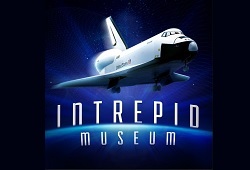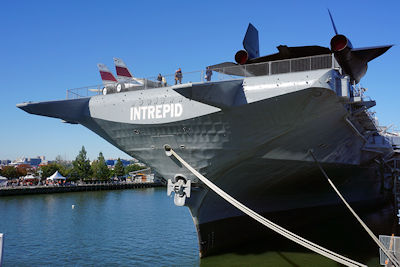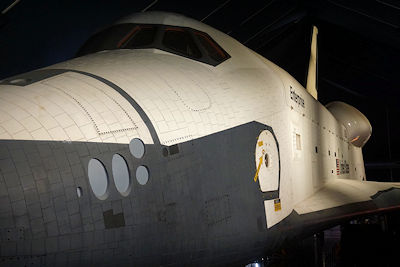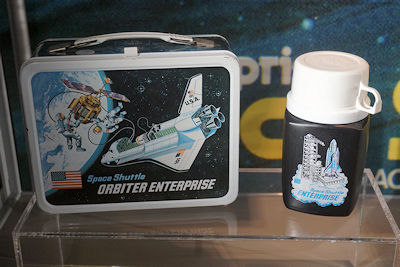
“Space – the Final Frontier. These are the voyages of the starship Enterprise. Its five-year mission: to explore strange new worlds. To seek out new life and new civilizations. To boldly go where no man has gone before!”
Those words were first spoken by Captain James T. Kirk in 1966 as an introduction to the original Star Trek television series. Eleven years later, they could very well have served as an introduction to NASA’s post-Apollo space program and its initial Space Shuttle, likewise named Enterprise. Both crafts – one fictional, one factual – served as flagships of their respective agencies, represented a new era in space exploration, and captured the imagination of millions upon their initial unveiling.
Both Enterprises also never completed their missions. Although Captain Kirk proclaimed a five-year mission for his Enterprise, Star Trek was cancelled by NBC after only three seasons. The Space Shuttle Enterprise, meanwhile, was originally a prototype vehicle that was intended to be retrofitted for space travel after a series of tests. That retrofitting never took place, as eventual redesigns of the Space Shuttle made the cost too expensive. Yet neither of those setbacks has diminished the importance of either Enterprise, as each is as culturally relevant today as when they were first introduced.
When the Space Shuttle program ended in 2011, NASA decided to refurbish the surviving Shuttles for educational purposes and distribute them to museums across the country. Enterprise had already been on display at the Smithsonian Air and Space Museum but was subsequently awarded to the Intrepid Sea, Air & Space Museum in New York City. The Shuttle was flown to JFK International Airport on top of a Boeing 747 in April 2012, then transported to the Intrepid by barge shortly thereafter.
In many ways, the Intrepid is an ideal home for the Space Shuttle. The USS Intrepid is an Essex-class aircraft carrier built during World War II that was decommissioned in 1972. Rescued from the scrapyard by a trio of real estate developers and philanthropists, it was later turned into a floating museum on the Hudson River. Along with its service in World War II and Vietnam, the USS Intrepid is also part of NASA history as it served as a recovery ship for both the Mercury and Gemini space programs.
On May 24, 1962, astronaut Scott Carpenter become the sixth human to travel into space when his Mercury capsule Aurora 7 completed three orbits around Earth, duplicating John Glenn’s historic flight three months earlier. The USS Intrepid was one of the aircraft carriers assigned for recovery, and its helicopters were the first to reach Carpenter after the Aurora 7’s re-entry was 250 miles off course due to a targeting error.
In March 1965, the USS Intrepid was again on hand for the recovery of the first manned Gemini mission. Just as with the Mercury splashdown, the Gemini spacecraft – nicknamed Molly Brown – landed 45 miles off course, resulting in a half-hour delay in recovery. It was again the Intrepid that arrived first, retrieving crewmembers Gus Grissom and John Young as well as the Molly Brown itself.
The Space Shuttle Enterprise now adds to the allure of the Intrepid for space enthusiasts. Located in a specially-built pavilion on the aft end of the aircraft carrier, Enterprise has a “cleaner” look than its Shuttle counterparts due to having never traveled beyond Earth’s atmosphere. Enterprise likewise lacks protective thermal tiles on its underbelly and main engines in its rear, but its importance to the Shuttle program cannot be understated.
Originally intended to be named Constitution in honor of America’s bicentennial, a letter writing campaign resulted in over 400,000 requests that the inaugural Space Shuttle be christened Enterprise instead. President Gerald Ford consented, and the Space Shuttle Enterprise was unveiled to the public on September 17, 1976, with Star Trek creator Gene Roddenberry and actors DeForest Kelley, Walter Koenig, Nichelle Nichols, Leonard Nimoy, and George Takei in attendance.
The Space Shuttle Enterprise immediately captured the imagination of the country just as its fictional counterpart did in 1966 with the television debut of Star Trek. Scale models, toys, games, and even lunch boxes quickly began appearing on store shelves, steel manufacturer Armco and the Ford Motor Company used images of the Enterprise in advertisements, and a replica Space Shuttle even appeared in the 1979 James Bond film Moonraker.
The Space Shuttle program lasted from 1981 until 2011, and encompassed 134 orbital flights. While no Shuttle ever explored “strange new worlds” like the Enterprise of Star Trek, the Enterprise exhibit at the Intrepid Sea, Air & Space Museum demonstrates that the program had a profound effect nonetheless, with over 100 technological advancements becoming part of everyday life as a direct result of Space Shuttle missions.
The list includes new methods in the preservation of fresh fruits and vegetables, the treatment of cancer and diabetes, air purification, cardiopulmonary resuscitation (CPR), eyewear, and home energy conservation.
In 1966, the original Star Trek television series inspired a generation of youths to explore science and engineering as fields of study. Ten years later, the Space Shuttle Enterprise instilled that same sense of wonder and imagination in a new generation in much the same way. Neither the Enterprise of Star Trek nor the Enterprise of the Space Shuttle program actually ventured into space in the real world, but their legacies live on at the Intrepid Sea, Air & Space Museum in New York City and continue to serve as an inspiration for future generations as well.
Anthony Letizia





